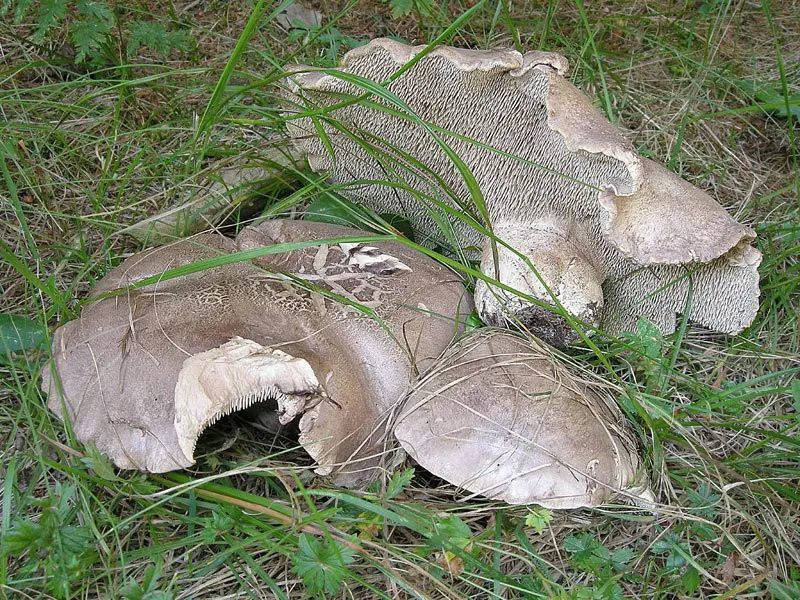White-legged hedgehog (Sarcodon leucopus)
- Division: Basidiomycota (Basidiomycetes)
- Subdivision: Agaricomycotina (Agaricomycetes)
- Class: Agaricomycetes (Agaricomycetes)
- Subclass: Incertae sedis (of uncertain position)
- Order: Thelephorales (Telephoric)
- Family: Bankeraceae
- Genus: Sarcodon (Sarcodon)
- Type: Sarcodon leucopus (Hedgehog)
- Hydnum leucopus
- Fungus atrospinosus
- Western hydnus
- A colossal hydnus

The white-legged urchin can grow in large groups, mushrooms often grow very close to each other, so the hats take on a wide variety of shapes. If the mushroom has grown singly, then it looks like the most ordinary mushroom with a classic hat and leg.
head: 8 to 20 centimeters in diameter, often irregular in shape. In young mushrooms, it is convex, flat-convex, with a folded edge, smooth, finely pubescent, velvety to the touch. The color is light brown, grayish brown, bluish-purple shades may appear. As it grows, it is convex-prostrate, prostrate, often with a depression in the center, the edge is uneven, wavy, “ragged”, sometimes lighter than the entire cap. The central part of the cap in adult mushrooms may crack slightly, showing small, pressed, pale purplish-brown scales. The color of the skin is brown, reddish-brown, bluish-lilac shades are preserved.
Hymenophore: spines. Quite large in adult specimens, about 1 mm in diameter and up to 1,5 cm long. Decurrent, first white, then brownish, lilac-brownish.
Leg: central or eccentric, up to 4 centimeters in diameter and 4-8 cm high, seems disproportionately short in relation to the size of the cap. May be slightly swollen in the center. Solid, dense. White, whitish, darker with age, in the color of the cap or grayish-brown, darker downwards, greenish, grayish-greenish spots may appear in the lower part. Finely pubescent, often with small scales, especially in the upper part, where the hymenophore descends onto the stem. White felt mycelium is often visible at the base.

Pulp: dense, white, whitish, may be slightly brownish-pinkish, brownish-purple, purplish-brown. On the cut, it slowly acquires a gray, bluish-gray color. In old, dried-up specimens, it may be greenish-gray (like spots on the stem). The mushroom is quite fleshy both in the stem and in the cap.
Smell: pronounced, strong, spicy, described as “unpleasant” and reminiscent of the smell of soup seasoning “Maggi” or bitter-amaret, “stone”, persists when dried.
Taste: initially indistinguishable, then manifested by a slightly bitter to bitter aftertaste, some sources indicate that the taste is very bitter.
Season: August — October.
Ecology: in coniferous forests, on soil and coniferous litter.
There is no data on toxicity. Obviously, the white-legged urchin is not eaten because of the bitter taste.
The white-legged urchin is similar to other urchins with caps in brownish, reddish-brown tones. But there are a number of significant differences. So, the absence of scales on the hat will make it possible to distinguish it from the Blackberry and the Blackberry rough, and the whitish leg from the Finnish Blackberry. And be sure to keep in mind that only the white-legged blackberry has such a strong specific smell.
Photo: funghiitaliani.it









